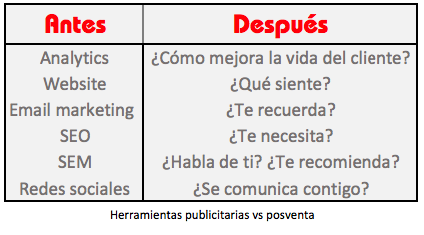Written by Rubén Martínez
Índice
Beyond emotional marketing
A mistake that is often made in the first stage after the emergence of a new business idea is to isolate ourselves mentally and physically, to imagine all that we are going to achieve and to hide from telling anyone, fearful that they might steal it from us. This clashes head-on with a basic rule: what you think about your business is usually not worth much. Hundreds of stores close every day without the businessman finding an explanation for the fact that his product, which he loves, is not selling. In many cases, one of the main causes of this is that communication with the customer has been non-existent.
The humanization of online marketing
If you don’t know what your customer wants, what your customer needs, you won’t be able to sell it to them, and to find out, you may have to ask them. It is true that today we have a large number of technological resources for the analysis of interests, search trends and online behavior of different sectors of the population. However, by communicating with your customers, asking them what they want and what makes them happy, they will give you the most valuable information you can find. Think about which are the best means of communication that you have at your disposal and that can facilitate this task, you have an infinite number of them.
The process of humanization of online marketing is the path that a company should follow to enhance the most emotional aspects of its campaigns, so that it achieves much more than customer satisfaction. The purpose of this process is to go beyond analytics, going one step further to captivate the consumer.
In line with Google: customer satisfaction is not enough
Over the past few years, advances in artificial intelligence implemented in Google’s algorithm have made it more and more human-like. This has made it easier to clearly focus on offering the most suitable product to the customer, in this case, the product that would make the customer live the best experience. Based on this, it began to give greater visibility to websites optimized for the best user experience in their navigation, devaluing factors that until now had been key to achieve a good positioning. That is why we must manage to go beyond the digital barrier to reach people’s hearts.
If we know how to observe, Google is giving us valuable clues that can be extrapolated to the business environment. Why don’t you also start thinking about what you want your customer’s experience to be when they buy your product? Why don’t you start thinking differently and work to ensure that your customer radically improves his life with your product or can’t live without it?
The success of your campaign must transcend the Internet wall, since part of it is also the customer’s experience with your product. From here, the impact of your next campaigns will be greater.
Think about a long-term content strategy.
Not having planned what we want to achieve in a year’s time will more than likely lead to a failure in our strategy. We must be very clear about where we want to be in that period of time and work every day to get progressively closer. Usually the customer’s journey is long and consists of several phases in which they are documented to make the best decision, so you should consider being there to take care of solving problems and doubts to your customers as a first approach to them. Unconsciously, they will make the decision to return or not based on the experience they have had during this trip and after the purchase of the product or service.
If you are going to give a global approach to your online marketing strategy focused simply on the creation of a website with a series of requirements and an investment in campaigns, to achieve a high conversion rate in a timely manner, you should step on the brakes and rethink several issues. What do you plan to do when the initial impact period is over? By the time this happens, you should have a new plan in place in which you are able to present a new and better product with a new and better campaign.
Let’s suppose you create a blog in which every week you publish an article about exercise and nutrition for a healthy life. The articles are of high quality and provide very interesting data for the readers, so much so that they start subscribing so as not to miss any post. Focusing on long-term profitabilityIt would be a great idea to start preparing a series of videos in which you not only expand the information you give in the post with some tricks, but you can also explain graphically how the exercises you propose for that week, proposing to make a video for each week of the year. In this case, video marketing would bring a much greater value to the weekly updates that would help you increase the level of subscribers once it starts to stabilize. At the same time and foreseeing the increase of followers, you could start thinking about different actions to carry out at the end of this stage, such as a tour of paid workshops at national level, visiting those provinces where the majority of subscribers are located. In this way you will have built up during the initial stage a large database of subscribers to whom you have been offering information and resources in a disinterested way and to whom you will finally give the opportunity to access an exclusive premium service.
Marketing before and after the sale
In the table on the left, we present some of the resources we can use to reach the customer and achieve a conversion. On the right, the reasons why that customer would come back to you for more conversions. Why are you going to set up an ecommerce with inventory, stock, logistics, analytics, campaigns, pricing strategy, etc., if you are not going to work to somehow improve the lives of those who buy your product?
Let’s take an example: Íñigo and Silvia create their own online stores where they offer childcare and baby food products. After one year, both achieve similar visibility in search engines and an equivalent level of visits with an equal conversion rate. Iñigo is happy and satisfied with his results, however, Silvia is aware that she has only started to do her job well and decides to take an interest in her customer by sending out feedback surveys where she offers compensation in case there has been a problem with the item or the shipment. At the same time, it decides to monitor each customer’s purchases in order to offer parents, after a few months, items that may be useful once their little one has grown up, by requesting the baby’s date of birth at the time of user registration or based on the age range to which the purchased product belongs. In addition, he thinks it would be a nice touch to selflessly send a gift to each child for his or her birthday. And it does not stop there, but decides to launch an exclusive offer for customers who spend more than €5,000 in a year in your store and send them a gift voucher for a family photo shoot in the best studio in your city.
As a result, after two years, Silvia not only grows exponentially in new customers thanks to a great online work, but she keeps them and keeps them coming back to buy again and again throughout the growth stage of her children. On the other hand, Inigo continues to be satisfied with a conversion level very similar to the one he had after a year and wondering where is the promotion he was hoping for.
Create expectations and exceed them
Let’s think that you achieve the first position in Google ranking with an important keyword for your sector and you start to notice an increase in sales. Objective achieved? Not at all, you will only have achieved a little less than half of the goal. What happens if you sell a product that, even though it is cheaper than your competitor’s, does not cross the customer’s emotional surface? Simply put, you stay on the surface and, as we said before, this customer will not come back.
It is time to change the mentality of online marketing, we must stop thinking that only through the tools and technique we can achieve the objectives, to start approaching the most emotional part of our customer, because that is where the real success of all our marketing campaigns lies.


